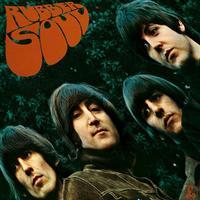The Beatles - Rubber Soul

|
| Label: |
EMI |
| Genre: |
Pop/Rock |
| Product No.: |
AEMI 82418
|
| UPC: | 094638241812 |
| Availability: |
In Stock
|
| Category: |
180 Gram Vinyl Record |
Cut at Abbey Road Studios using non-limited 24-bit digital masters sourced from the original analog master tapes!
Pressed on 180-gram vinyl; Rubber Soul's North American LP debut in stereo
Optimum audiophile-quality sound from a first-rate team of producers and engineers
Rolling Stone 500 Greatest Albums of All Time - Rated 5/500
For years the most anticipated vinyl reissues have been from the one, the only Beatles catalog. Finally, after a delay due to the meticulousness of the remastering process and assorted other hurdles, that day has come. The Beatles catalog is getting the audiophile treatment! 180-gram vinyl pressings cut at Abbey Road Studios using the non-limited 24-bit digital masters sourced from the original master tapes!
Released in 1965, Rubber Soul signified a sea change for the Beatles. The record marked the emergence of John Lennon and Paul McCartney's distinctive identities as songwriters. It featured an original ("Nowhere Man") that went beyond the band's commonplace love themes. And its sound departed from the echo-laden nature of its predecessors, an intentional move that offset it from the multiple bands that had been copying the Beatles' style. Still, Rubber Soul retained a constant: It was yet another watershed collection of pop and rock by a group that redefined the genres as it went along.
For its Beatles' Stereo Albums series on LP, Capitol/Apple turned to a crack team of engineers to remaster Rubber Soul from the original sources. The team, including Guy Massey, Steve Rooke and Sam Okell with Paul Hicks and Sean Magee undertook a four-year restoration process for the LP versions, combining state-of-the-art equipment, vintage studio gear and rigorous testing to meet the highest fidelity standards and produce authentic unsurpassed sound rivaling the original LPs.
Hence, the definitive aspects of Rubber Soul are enjoyed like never before. Take George Martin's piano solo on "In My Life," half-speed overdubbed to make it sound like a harpsichord. Does it ever. Or Lennon's pronounced intakes of breath during the choruses to the sweet "Girl." You can practically feel the air moving into his lungs. The inimitable ringing of the sitar on "Norwegian Wood" becomes life-size. The unique tonalities of George Harrison's newly acquired Fender Bassman amplifier are seemingly visceral in appearance.
Sonically, Rubber Soul claims a much drier sound, as the band elected to refrain from utilizing echo chambers and minimized the amount of reverb present on its earlier albums. The decision further distinguished the Beatles from their peers. And contributed to the impact of the music. Acoustically based, Rubber Soul is identified by hard-panned left-to-right channel production, which on this pressing throws the group's instrumentation and vocals into greater relief. Even if you've heard Rubber Soul a thousand times, you haven't truly experienced it until you hear this analog pressing.
Help! and Rubber Soul were mastered using digital remixed versions that George Martin, the group’s producer, oversaw in 1986. Extensive testing was done before engineers copied the analog master tapes into digital files using 24-bit/192 kHz resolution and a Prism A-D converter. Dust build-ups were removed from tape machine heads after the completion of each title. Artifacts such as electrical clicks, microphone vocal pops, excessive sibilance and poor edits were improved upon as long as they were judged not to damage the integrity of the songs. The 24/192 transfers were done to produce an archival copy of the tapes and then those files were reduced to 24/44.1 kHz files for final mastering. De-noising technology was applied in only a few necessary spots and on a sum total of less than five of the entire 525 minutes of Beatles music.
The digital files were cut to lacquers at Abbey Road Studios. Engineer Sean Magee cut the LPs in chronological release order. He used the original 24-bit remasters rather than the 16-bit versions that were required for CD production. It was decided to use the remasters that had not undergone "limiting," a procedure to increase the sound level.
Steps to eliminate vocal distortions and inner-groove distortions were addressed using a digital workstation. The latter can affect high-middle frequencies, producing a "mushy" sound noticeable on vocals. Using what Magee has described as "surgical EQ," problem frequencies were identified and reduced in level to compensate for this.
Lastly, the first batches of test pressings made from the master lacquers that had been sent to two pressing plants were judged. Records with any noise or click appearing on more than one test pressing in the same place were rejected, on the grounds that undesired sound had been introduced either during the cutting or pressing stage.
For producer Rick Rubin, The Beatles' recorded achievements are akin to a miracle. The most popular bands in the world today typically produce an album every four years, Rubin told a 2009 radio audience. That's two albums as an eight-year cycle. "And think of the growth or change between those two albums. The idea that The Beatles made thirteen albums in seven years and went through that arc of change ... it can't be done. Truthfully, I think of it as proof of God, because it's beyond man's ability."
| Side 1 | Drive My Car | Norwegian Wood (This Bird Has Flown) | You Won't See Me | Nowhere Man | Think For Yourself | The Word | Michelle | Side 2 |
What Goes On | Girl | I'm Looking Through You | In My Life | Wait | If I Needed Someone | Run For Your Life |
|
View other items by The Beatles |
|
 In-Stock Music Orders Over $99 SHIP FREE Within The Continental U.S.
In-Stock Music Orders Over $99 SHIP FREE Within The Continental U.S.







 Login
Login
 My Account
My Account
 Cart
Cart Wishlist
Wishlist
 Contact
Contact




